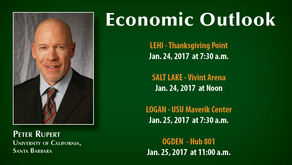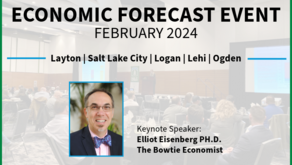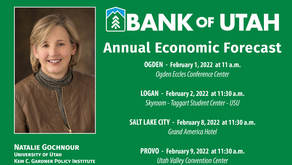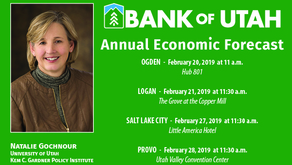A variety of knowledgeable economists and financial experts shared valuable insights into the labor, housing and global markets at Bank of Utah’s Economic Forecast events in Logan, Provo, Ogden and Salt Lake City Feb. 7-10, 2023.
Different speakers addressed crowds at each of the four locations and spoke to an impending recession, rising interest rates, falling unemployment and a number of other financial and world topics that are top of mind for many people today. As the presentations were made, speakers noted that things will turn around and that the Utah economy is a bright spot in many ways.
Here is a breakdown of our speakers’ messages:
Logan and Provo Forecast Events – Lindsey Piegza and Lauren Henderson from Stifel Financial
Logan’s forecast event featured Lindsey Piegza, chief economist from Stifel Financial. In Provo, Lauren Henderson, also an economist from Stifel, shared a similar message relating to the Federal Reserve's ongoing dilemma of taming inflation vs. ensuring recession. Their comments centered around the national economy, focusing on unemployment and how much it affects every other part of the economy. They also addressed the housing market and how home prices are still elevated despite the rising interest rates.
Piegza said that while employment is still below the level of pre-COVID numbers, we are seeing large gains in the labor market. “Robust is overstating the health of the labor market,” she said. In January alone, 517,000 payrolls were added nationally. The working world has changed greatly since the pandemic, but people are going back to work. Some fields are still in decline though. The leisure and hospitality fields are still limping along with over 8 million jobs lost during the pandemic. The rate is rising to almost 7 million gained back as of January 2023.
Both Piegza and Henderson said the labor demand outpaces labor supply right now. In December 2022 job openings jumped from 10.4 million to 11 million nationwide. There has been a demand for over 10 million jobs for the past 18 months. “Producers remain desperate for workers to increase output and meet a still-heightened level of demand for goods and services,” Piegza said. Right now there are around two open positions for every one person who is a seeking a job. She noted that while unemployment is low at 3.4 percent, it doesn’t account for people who are not actively seeking employment. The real question remains as to why some aren’t seeking employment. She said that some may still be feeling fearful of fallout from the pandemic, are receiving unemployment benefits or are worried about the spread of the virus. The biggest contributing factor is those not working because they are caring for children. That makes up 4.8 million of those not working.
According to Piegza and Henderson, that will change. People’s savings are dwindling and won’t support people indefinitely and they will have to return to the job market. While they can use credit cards or other debt, it can’t last forever.
As for housing, there is a waning demand nationwide. Home prices are still elevated, but they are slowing. Both noted that prices are a bit higher in Utah (16.7 percent) but down from 26.2 percent in the second quarter.
Piegza and Henderson talked about how the Fed is trying to win the inflation game and that the worry, according to Chairman Jerome H. Powell, is not that the Fed overtighten, but that they are not doing enough to control inflation, hence a continued hike in interest rates. Piegza referred to the “inflation dragon” weakening our economy, but our unemployment rate could outweigh our chances of going into a recession. Both economists said it will take some time, but things will improve by next year.
To review the presentation deck, click here.
Dr. Lindsey Piegza's Logan Presentation
Ogden’s Forecast Event – Michael Jeanfreau, Utah Department of Workforce Services; Miles Hansen, President and CEO, World Trade Center, Utah; and Brian Smedley, Chief Economist, Head of Macroecomic and Invest Research Guggenhiem Investments
In Ogden, three speakers shared insights about our local, national and international economies.
On the local front, Michael Jeanfreau of the Utah Department of Workforce Services, spoke about Utah’s economy, sharing Utah has been doing “really well” compared to some other states as far as job loss, growth and inflation. Right now employment in Utah is above pre-pandemic levels – up 70,000 from before the pandemic. Almost every industry has seen grown since before the pandemic. Utah is second in the nation in job growth (Idaho is first).
Jeanfreau shared that one of the biggest reasons for job growth is overall population growth. More people are moving to Utah domestically, even though natural increase is down somewhat. The biggest areas in the state seeing the most growth appear to be rural areas in Cache and Box Elder counties, he said.
He feels confident that inflation will start slowing, especially in Utah due to job growth and population growth. Wage growth is up, especially in service occupations in Utah. As he defined inflation – more money chasing fewer goods – he noted there are four factors driving inflation:
- Federal aid from the pandemic.
- High demand for goods.
- Supply chain disruption/Ukraine war.
- Labor shortage.
With rising interest rates, no more federal aid and the supply chain coming back into line, inflation is bound to go down eventually.
Retirement of baby boomers has contributed to inflation, as well as people having fewer children. “People not having more kids is a potential problem,” Jeanfreau said. A recession is likely, but won’t hit Utah quite as hard, he said. He gave six solutions to help the economy and prevent recession:
- Incentivize or pressure Baby Boomers to keep working.
- Import products and meet demand.
- Import labor from other countries.
- Offset the departing labor with automation and artificial intelligence.
- Incentivize births.
- Let the economy naturally shrink.
To review Michael Jeanfreau's presentation deck, click here.
The second speaker in Ogden, Miles Hansen, works with global partners around the world to help Utah businesses. He maintains that the economic forecast is brighter than most think. “In looking at global dynamics…a vast majority of people are inherently good,” he said. “There is no one-size-fits-all approach,” Hansen said in regard of how to handle the economy.
He noted that many people have concerns about the relationship between the United States and China. In his position with World Trade Center Utah, he has seen that the relationship is not as bad as some think. The U.S./China bilateral trade reached an all-time high this past year, indicating relations in trade are good, he said. “We can’t cut all ties…with China,” Hansen added.
His outlook on the overall world economy in relation to Utah was positive. “The future is bright in the state of Utah,” he said with confidence.
Brian Smedley was the final speaker at the Ogden Forecast Event. His remarks centered around the topic: “An Investor’s Guide to the Coming Recession.” Smedley, a chief economist at Guggenheim Investments, said aggregate demand growth is overheated, but is cooling fast. He, like the presenters from Stifel, shared that the demand for labor is quite strong, but the downside to that is low unemployment often precedes recessions.
He talked about inflation, saying it is higher than it’s been in 40 years, but it is slowing which is good. For the Fed, in order to control inflation, there needs to be a softer labor market. He showed a graph explaining the interest rate projections through January 2024. The trend is that the rates will peak above 5 percent in Q2, but eventually start to go back down this summer. “Forecasters have never been so confident that a recession is coming,” Smedley said, adding that a recession is predicted to start in 2023. It is also predicted that unemployment will rise. The idea of a debt limit fight will not help, he said. It could lead to fiscal tightening and hurt growth.
Investors should consider taking a defensive stance and be cautious. As far as housing investing, the structural housing supply shortage will put limits on the downside to home prices.
Smedley’s realistic outlook provided investors food for thought for the future.
To review Brian Smedley's presentation deck, click here.
Salt Lake City’s Forecast Event: Economist David Bridges from Fidelity Investments
David Bridges spent his speaking time sharing his vast knowledge of foreign affairs and global forecasts. He spoke to current issues and how they affect people living in the United States. He talked about relations with China, Taiwan and Russia.
In talking about China, he said that Chinese leadership wants a pragmatic relationship with the United States and while we have issues, it is important to keep up communication. “Will we resolve our differences with China? No. Will we go to war? Probably not,” Bridges said.
He spoke a great deal about the Russia/Ukraine conflict and how it affects the United States. The Russian military is getting weaker, he said, but it will be hard for Vladimir Putin to accept defeat. The biggest thing to consider is what will happen if the Russian leadership has issues with Putin – if they decide to remove him from power in some way. “What lies ahead is alarming…we are not in a position to shape political outcomes in other countries,” he said. “Our U.S. military is the most formidable military in the world. We are a formidable foe,” he said. But there are other ways that Russia and other countries like China are fighting and that is through cyber-attacks and sabotage. He admitted the United States can battle on those fronts, but it will be more of a fight. “We are the best,” he said of the United States in both categories.
He also spoke to population growth moving away from the northwest part of the world. “There is a tremendous population growth that developed countries are not paying attention to…countries like Nigeria and Congo,” he added. But, in his view, the genius of America is in its ability to import talent. In that way, the United States will be successful.
We appreciate all the speakers and the thought-provoking information provided to help prepare for an interesting year ahead. Bank of Utah President Branden Hansen shared over the course of the week that “we live in unprecedented times” and how helpful it was to hear from experts on how to navigate during these times.




